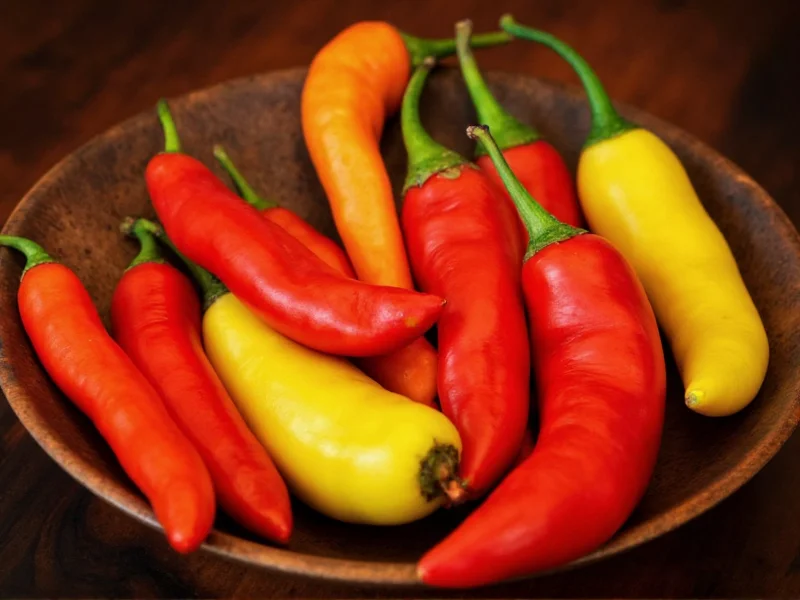When exploring are serrano chilis hot, it's essential to understand their precise position on the heat spectrum. Serrano peppers (Capsicum annuum) originate from the mountainous regions of Mexico and have become staples in Mexican cuisine and increasingly popular in global cooking. Their distinctive heat profile makes them versatile for salsas, guacamole, and various cooked dishes where a pronounced but manageable spice level is desired.
Understanding Serrano Pepper Heat Levels
The heat in serrano chilis comes from capsaicin, the compound responsible for spiciness in all chili peppers. Unlike milder peppers like poblanos or bell peppers, serranos deliver a sharp, immediate heat that intensifies when cooked. The Scoville scale provides the standard measurement for chili pepper heat, and serranos firmly sit in the medium-hot category.
| Pepper Variety | Scoville Heat Units (SHU) | Heat Comparison to Serrano |
|---|---|---|
| Bell Pepper | 0 SHU | Not spicy |
| Jalapeño | 2,500-8,000 SHU | 2-5 times milder than serrano |
| Serrano | 10,000-23,000 SHU | Baseline |
| Cayenne | 30,000-50,000 SHU | 1.5-2 times hotter than serrano |
| Habanero | 100,000-350,000 SHU | 5-15 times hotter than serrano |
Factors That Influence Serrano Pepper Heat
Several elements affect how hot serrano peppers actually taste when you use them in cooking:
- Growing conditions: Stressors like limited water or nutrient-poor soil increase capsaicin production, making peppers hotter
- Ripeness: As serranos mature and change color from green to red, orange, or yellow, their heat intensifies
- Part of the pepper: The placenta (white ribs and seeds) contains the highest concentration of capsaicin
- Cultivar differences: Some serrano varieties are selectively bred for milder or hotter profiles
Practical Uses for Serrano Chilis in Cooking
Understanding are serrano peppers hotter than jalapeños helps determine their best culinary applications. Chefs and home cooks value serranos for several reasons:
Unlike jalapeños that often require multiple peppers to achieve noticeable heat, serranos deliver robust spice with fewer peppers. Their thinner walls and crisp texture make them ideal for raw applications like fresh salsas and pico de gallo. When cooked, serranos maintain their distinctive flavor while mellowing slightly in heat intensity.
For those exploring serrano chili heat level explained in practical terms, consider these usage tips:
- Always wear gloves when handling serranos to prevent skin irritation
- Remove seeds and white membranes for milder heat while retaining flavor
- Balance serrano heat with acidic ingredients like lime juice or vinegar
- Pair with dairy products (sour cream, cheese) to counteract excessive heat
- Start with small amounts and adjust to taste—serranos can quickly overpower a dish
Serrano Peppers vs. Other Common Chilies
When evaluating how hot are serrano peppers compared to jalapeños, the difference becomes immediately apparent. A typical jalapeño measures 2,500-8,000 SHU, while serranos start at 10,000 SHU—meaning even the mildest serrano exceeds the hottest jalapeño.
Compared to other peppers:
- Thai bird chilies (50,000-100,000 SHU) are significantly hotter than serranos
- Cayenne peppers (30,000-50,000 SHU) deliver about twice the heat of serranos
- Fresno peppers (2,500-10,000 SHU) have similar heat to jalapeños but with a fruitier flavor
- Habaneros (100,000-350,000 SHU) provide dramatically more heat than serranos
Understanding these comparisons helps answer the common question: are serrano peppers hotter than jalapeños? Absolutely—they're consistently 2-5 times hotter, making them a substantial step up in heat intensity.
Safety Tips for Handling Hot Peppers
Working with serrano chilis requires proper precautions. The capsaicin that gives serrano pepper Scoville scale rating its impressive number can cause significant discomfort if mishandled:
- Always wear disposable gloves when cutting or handling serranos
- Avoid touching your face, especially eyes, while working with hot peppers
- Wash hands thoroughly with soap and water after handling, even when wearing gloves
- Use separate cutting boards for hot peppers to prevent cross-contamination
- If skin irritation occurs, apply milk or yogurt to neutralize the capsaicin
Remember that cooking doesn't eliminate capsaicin—it merely distributes it throughout your dish. Understanding using serrano chilis in cooking safely ensures you enjoy their flavor without overwhelming heat.
Conclusion
To definitively answer are serrano chilis hot: yes, they're significantly hotter than common jalapeños but remain accessible for most spice enthusiasts. Their 10,000-23,000 SHU rating places them firmly in the medium-hot category, offering a vibrant, clean heat that enhances rather than dominates dishes. Whether you're making authentic Mexican salsas or experimenting with global flavors, serranos provide reliable heat with distinctive flavor when used appropriately.
Frequently Asked Questions
How much hotter are serranos than jalapeños?
Serrano peppers are typically 2-5 times hotter than jalapeños. While jalapeños measure 2,500-8,000 Scoville Heat Units (SHU), serranos range from 10,000-23,000 SHU. This means even the mildest serrano exceeds the hottest jalapeño, making them a substantial step up in heat intensity for cooking.
Can you substitute serrano peppers for jalapeños in recipes?
Yes, but with caution. Since serranos are significantly hotter than jalapeños, you'll need to use fewer serranos to achieve similar heat levels. As a general rule, use half as many serranos as the recipe calls for jalapeños, then adjust to taste. Remember that serranos also have thinner walls and a slightly different flavor profile.
Why are some serrano peppers hotter than others?
Serrano pepper heat varies due to growing conditions, ripeness, and genetics. Stressors like limited water increase capsaicin production. Riper (red) serranos are typically hotter than green ones. The white membranes and seeds contain the most heat, so removing these reduces spiciness. Different cultivars also have naturally varying heat levels.
How can I reduce the heat of serrano peppers in cooking?
To reduce serrano heat, remove all seeds and white membranes (placenta), which contain most capsaicin. Soaking sliced peppers in salt water or vinegar for 15-30 minutes can also draw out some heat. Cooking with dairy products like sour cream or cheese helps counteract spiciness. Start with small amounts and gradually add more until you reach your desired heat level.











 浙公网安备
33010002000092号
浙公网安备
33010002000092号 浙B2-20120091-4
浙B2-20120091-4